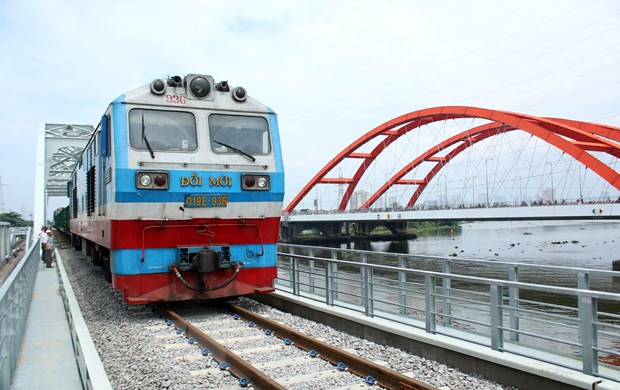 Society
Society

 |
| A North-South train running through the new Bình Lợi Railway Bridge over Sài Gòn River links Bình Thạnh District and Thủ Đức city in HCM City. — VNA/VNS Photo Tiến Lực |
HCM CITY — By 2030, Việt Nam’s railway industry will have nine new routes with a total length of 2,362 km, according to the railway network plan for 2021-30 period, with a vision to 2050, that was recently approved by the Prime Minister.
A North-South high-speed railway project will be submitted to the Politburo for approval in September, followed by a report to the National Assembly to launch in the 2021-26 period. After this will be feasibility reports, design considerations, and land clearance tasks.
In 2028-29, bidding on the Hà Nội – Vinh and HCM City – Nha Trang routes can begin.
The two railway construction projects of Biên Hòa - Vũng Tàu and Thủ Thiêm - Long Thành will be built under the Public-Private Partnership model, with investments of VNĐ50.8 trillion (US$2.2 billion) and VNĐ40.6 trillion ($1.7 billion), respectively.
The ministry’s Railway Project Management Board is assigned to organise bidding for a consultant who will develop a pre-feasibility report for both projects by the third quarter of this year.
For the HCM City - Cần Thơ rail line, the Transport Ministry is working with related localities to choose the optimal route and investment method to be completed this year to submit to the National Assembly for approval, after which the project will attract investment in 2024 and start construction in 2025 or 2026.
Bình Dương Province People’s Committee has announced that it is proposing an extension of the Bến Thành - Suối Tiên railway to the new downtown of Bình Dương Province. The first stage of this project for a 1.8km railway line will use ODA capital. The second stage with a length of over 25km from Dĩ An City to the new downtown is considered a strategic route to boost the socio-economic growth of the province and promote regional connectivity.
Minister of Transport Nguyễn Văn Thể said that the new railway projects were going to improve the country’s railway industry while becoming a new force for the growth of regional transportation to reduce logistics costs in the country, especially the South.
However, there are still many obstacles. Construction projects within the railway corridor are still being approved, leading to a rise in the amount for land compensation.
Therefore, closer collaboration among related ministries, state agencies, and local authorities is needed when greenlighting land use plans and managing land resources.
The most challenging obstacle seems to be attracting investment. It is estimated that the capital demand for these railway projects will reach VNĐ240 trillion ($10.3 billion), coming from both the State budget and other sources. The state budget will be used mostly for direct train structures, while other parts such as the station and parking areas should use other investment sources.
According to the railway network plan for 2021-30, with a vision to 2050, the People’s Committees of concerned provinces and cities must actively seek legal investment sources for the connection of their local railways from ports, economic zones, or tourism attractions to the national railway.
Therefore, going forward, the Government is going to develop a mechanism to encourage organisations and individuals, both inside and outside the country, to invest in railway projects, and a mechanism to better exploit the land resources around rail stations.
In 2018, the country’s railway network consisted of seven major routes with a total length of nearly 3,160km.
Nine new railway routes are planned to be completed by 2030. Cargo and passenger transport volumes are expected to reach 11.8 million tonnes and 460 million people. — VNS




